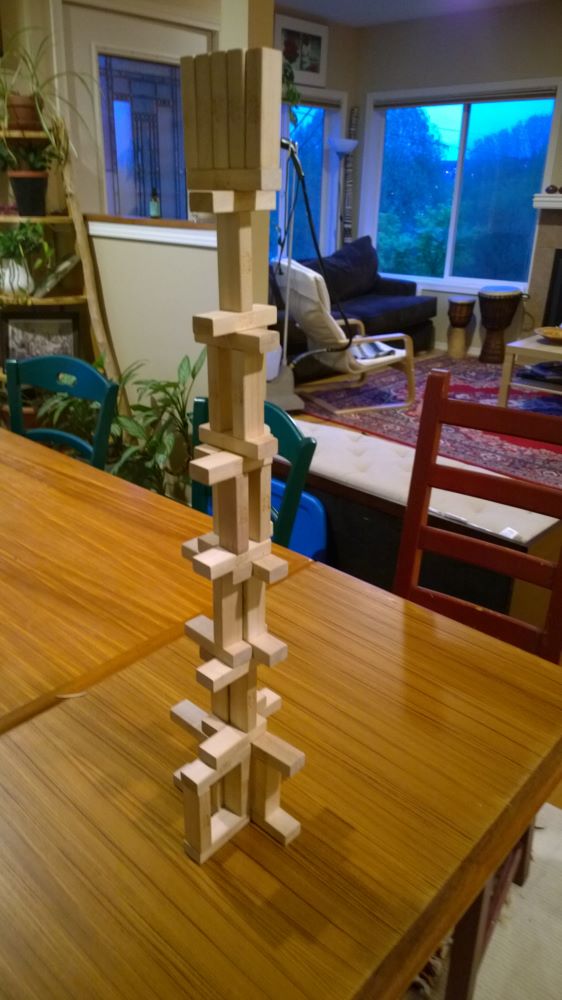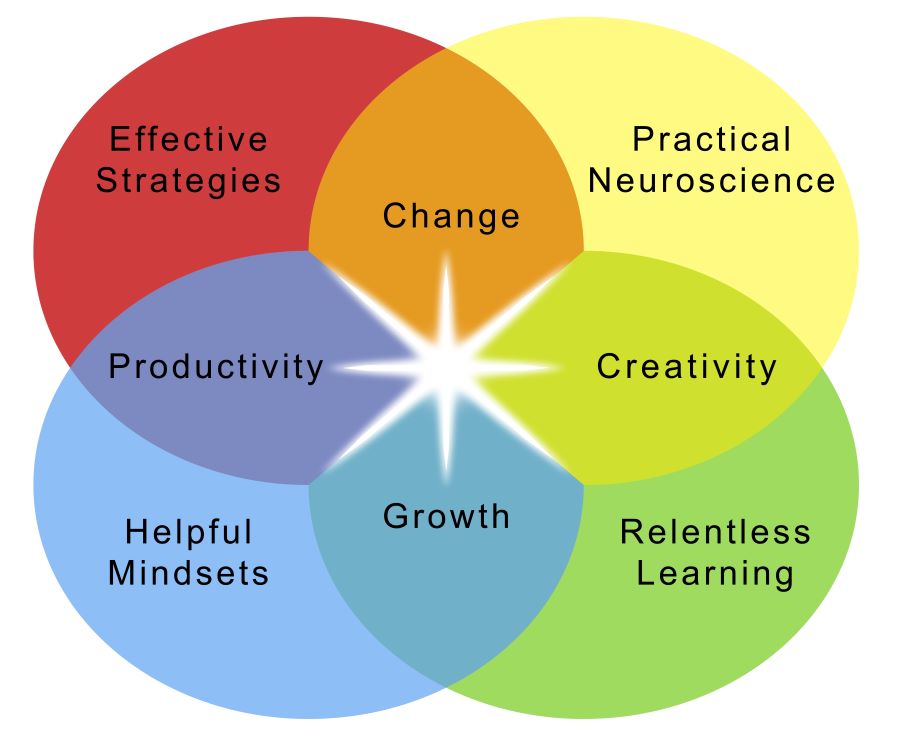
It could easily be argued that the hallmark of our species is creativity. Other animals are certainly creative, but no other species has taken innovation and art to such dramatic heights.
Here are some telling examples:
- In Birmingham, England, in 1867, factories were producing over 500 different types of hammers, each with a unique, specialized function.1
- In just the United States, over the past 200 years, over ten million patents have been issued.2
- Between 1957 and 1990 – a 33-year span of time – over ten million new chemicals were added to the American Chemical Society’s database.1
- As of right now, there were over 2.2 million apps available for your smartphone; 15 years ago, there were zero because smartphones didn’t exist.
- And currently, there are over 26 million songs available for purchase on iTunes, most from musical genres that didn’t even exist 100 years ago.
Humans create a lot, which begs the question: Where do all these ideas come from?
The answer to that question is not just intellectually interesting; it’s also highly practical. Understanding where new ideas come from will help you become more creative. It will help you innovate in your career, in your home, and in your hobbies, allowing you to lead a more successful and more satisfying life.
So let’s explore.
Form and Function
One classic dictum of technology is “form follows function.” This means that the design of any technology is based on its intended purpose; it has a particular form because of the function it’s supposed to serve. At first glance, this seems logical: a bowl is surely concave to hold liquid; a knife is surely sharp so it can cut. Inventors think of something they’d like to do, and then they design a tool to serve that purpose.
But does form really follow function?
The trouble with this paradigm is it fails to explain why the same problems have been solved by very different technologies. A pair of chopsticks and a fork solve the same problem – how to get food from plate to mouth – and yet they are radically different.

This example plainly shows that the explanation of how particular technologies come to be must be more complicated – and more interesting – than “form follows function.”1
In fact, the primary way that humanity gets so-called “new” ideas and technologies is not through invention at all. Rather, it is through evolution. Old things morph into new things, and change is gradual.
“Any new thing that appears in the made world is based on some object already there.” –George Basalla1
This parallels the gradual change in species caused by genetic mutations. Just as every species has a particular ancestry that led to its current form, every idea has a unique history that led to its current form. Hence, on one continent you might have pandas, and on another grizzly bears, while in one culture you might use chopsticks, and in another a fork.
And lest you think this is just about technology, let me point out that the same principle applies to our economic systems, our educational systems, our political systems, the art we make, and the philosophies we live by.
Wait, but why do the old things change at all? Why not just keep the current ones?
Good questions.
Perhaps the most common reason for an idea to evolve is the human propensity for finding faults with existing ideas. Henry Petroski, author of The Evolution of Useful Things, explains:
“Clever people in the past … observed the failure of existing things to function as well as might be imagined. By focusing on the shortcomings of things, innovators altered those items to remove the imperfections, thus producing new, improved objects.”1
Since there is always room for improvement, and because we’re always trying to make things better, change is constant. From entrepreneurship to political reform, many creative endeavors are driven by an effort to resolve dissatisfaction. Hence, Petroski argues, “form follows failure.”1
Making Improvements
Now, it’s not enough to merely notice what is lacking in our current ideas, systems, and technologies. As usual, complaining alone doesn’t help. Creative progress occurs when we imagine a better way, and then proactively take steps to bring that vision to life.
It’s tremendously rare to scrap the existing system completely and start from scratch. It is vastly more common to improve upon the existing system. Thus, gasoline-powered cars give way to hybrid cars, which give way to electric cars, and incandescent light bulbs give way to fluorescent light bulbs, which give way to LEDs. Reform, rather than revolution, is the norm.

In Guns, Germs, and Steel, Jared Diamond lays out a classic case, writing:
“We are regularly told, ‘James Watt invented the steam engine in 1769,’ supposedly inspired by watching steam rise from a tea-kettle’s spout. Unfortunately for this splendid fiction, Watt actually got his ideas … while repairing a model of Thomas Newcomen’s steam engine, which Newcomen had invented 57 years earlier … Newcomen’s engine, in turn, followed the steam engine that the Englishman Thomas Savery patented in 1698, which followed the steam engine that the Frenchman Denis Papin designed … which in turn had precursors.”3
Each step along the way, the “inventors” simply improved upon the previous model. Most progress comes from tinkering with old ideas. And many innovators rightly acknowledge this, as when Isaac Newton said:
“If I have seen further, it is by standing on the shoulders of giants.”
So here we find the innovator’s version of realistic optimism. To move humanity forward, one does not have to invent something entirely new. It can be enough to simply improve upon existing ideas.
And remember, creativity doesn’t have to be about important things. You can flex your creativity muscles purely for fun by, for instance, amending the rules to classic games to make them more interesting, as I’ve done with Jenga.

Okay, but what about big leaps forward? Sometimes we do invent something new. How does that happen?
Combinatorial Creativity
When we invent something new, it’s never completely new. It always (or nearly always)* contains one or more elements of old ideas. It’s just that rather than adjusting old ideas to improve upon them, we combine old ideas with other ideas. And it is these combinations that create something revolutionary.
* If you can think of an example of a new idea that was completely new, and not at all based on previous ideas, please let me know. I’m genuinely curious about this phenomenon. Send your thoughts to chris@becomingbetter.org
In his excellent book, Where Good Ideas Come From, Steven Johnson puts it this way:
“We take the ideas we’ve inherited or that we’ve stumbled across, and we jigger them together into a new shape.”4
- The first automobile combined an old idea – the carriage – with a new technology – the internal combustion engine (whose precursor was the aforementioned steam engine).
- The first light bulb combined an old idea – a lamp – with a newly harnessed force of nature – electricity.
- Gutenberg’s printing press combined Chinese movable type with a German wine press.4
- Darwin’s theory of evolution by natural selection combined preexisting ideas about geology, classification, and population pressure with his own observations of plants and animals.4
Speaking of biology, there’s a neat parallel here that helps make sense of where new ideas come from.
Biological Creativity
For most of the history of life on Earth, organisms only reproduced asexually – by making copies of themselves. The only changes were genetic mutations – copying errors. Since mutations are random, most are not helpful. But a tiny minority are helpful, and they stick around, leading to incremental improvements.
Then, about three-quarters of the way through the history of our planet, sexual reproduction arose. With sex, change could also result from combinations of genes. You get half your genes from Mom and half from Dad, so the hand you’re dealt comes from two genetic decks being shuffled together.
As a result, life diversified greatly. All multicelled life – most of the “nature” that we consider beautiful or interesting, including ourselves – is largely the result of this sexual revolution. Biological innovation accelerated dramatically because of combinatorial creativity on the genetic level.

Ideas Have Sex
Matt Ridley noticed the parallel between the shuffling of genes during sexual reproduction and the combinatorial nature of human innovation, and coined the phrase, “Ideas have sex.”5 Our ideas mingle with one another and reproduce, just as animals do, giving birth to a new generation of ideas.
We’ve all heard that Steve Wozniak and Steve Jobs started Apple Computers in a garage. Two geniuses working together in the near-solitude of a garage. Well, not exactly.
What most people don’t know is that those two met at a club for computer nerds. The meetings of the Homebrew Computer Club were freewheeling, idea-sharing events in which anyone who was working on building their own computer could share what they were working on or trade parts.6 The club didn’t just facilitate the meeting of Wozniak and Jobs, it filled their heads with ideas about computers. These ideas had sex, and Apple was born.
Despite Ridley’s sexy slogan, combinatorial creativity is as commonplace as peanut butter and jelly, or, if you prefer, peanut butter and chocolate. Indeed, Dan Pink called combinatorial creativity the “Reese’s Peanut Butter Cup Theory of Innovation,” telling the fable of accidentally combining chocolate and peanut butter, only to discover that they are more delicious together than they were apart.7
This is how new musical genres are created. Funk music was made by combining rock and roll with jazz. And then afrobeat music was made by combining funk with west-African tribal music. Hip-hop music is produced by sampling old music, adding new sounds, and combining it with poetry. Citing this, but also extending beyond the field of music, creativity expert Kirby Ferguson said, “Everything is a remix.”8

The things that combine don’t even have to be previously useful ideas. They can just be two features of the physical world that stumble into one another and inspire an invention. For example, Velcro was serendipitously invented when “Georges de Mestral noticed how burrs stuck to his dog’s fur.”7
It’s Still Creativity
Some people take offense at the notion that all creativity is based on preexisting ideas. They pride themselves on their originality and feel insulted by the implication that their creative work draws upon the ideas of others. They think that I’m saying they’re not really creative at all.
But this is hogwash.
Evolutionary creativity and combinatorial creativity are still creativity. Indeed, as I’ve argued, they may be the only kinds of creativity.
And the value of creative work is not measured by how original it is; it is measured by the actual value it creates. The fact that Gutenberg’s printing press was based on a German wine press and Chinese movable type doesn’t diminish the immense value created by making it vastly cheaper to produce books. The fact that Macklemore’s song “Otherside” drew heavily on a baseline from Red Hot Chili Peppers did not diminish the emotional impact it had on me when I was struggling with addiction.
Multiplication
When ideas combine it’s not a simple matter of addition; it’s a matter of multiplication. The results of combinatorial creativity are unpredictable and sometimes much more valuable than any of the puzzle pieces involved. The new whole is often far greater than the sum of its parts.
Think of a cake. If you simply laid out the ingredients on a table, they would offer very little value. But if combine them, you can create something magnificent.

Furthermore, ideas are a unique resource in that they are not diminished by sharing. George Bernard Shaw famously said:
“If you have an apple and I have an apple and we exchange these apples, then you and I will still each have one apple. But if you have an idea and I have an idea and we exchange these ideas, then each of us will have two ideas.” –George Bernard Shaw
What he failed to notice is that, often, when two people share ideas, those ideas will often procreate, leaving both people with more than two ideas each, and sometimes creating new ideas that are superior to either of the original ones. This is partly why it is said that two heads are better than one.
Likewise, two academic disciplines are better than one.
Interdisciplinary Creativity
Few people have done more for the study of creativity than Mihaly Csikszentmihalyi (“Me-high Cheeks-sent-me-high”). He studied creativity for many years and interviewed dozens of people renowned for their creativity from a range of disciplines: art, architecture, music, dance, engineering, biology, chemistry, physics, and business.
The men and women who fill the pages of his book (creatively titled Creativity) were highly diverse in their backgrounds as well as their achievements. But out of that great variety, some clear patterns emerged.
One is the ubiquitous experience of “flow” – a state of supreme focus and dynamic performance, which I detailed in this post.
Another important pattern he observed was interdisciplinary creativity. That is, innovations usually involve a cross-pollination of ideas from multiple academic or intellectual domains:
“Most breakthroughs are based on linking information that usually is not thought of as related. Integration, synthesis both across and within domains, is the norm rather than the exception. … almost all scientists cross and recross the boundaries of physics, chemistry, and biology in the work that turns out to be creative.”9
Csikszentmihalyi explains why this is the case:
“An intellectual problem is not restricted to a particular domain. Indeed, some of the most creative breakthroughs occur when an idea that works well in one domain gets grafted to another and revitalizes it. This was certainly the case with the widespread applications of physics’ quantum theory to neighboring disciplines like chemistry and astronomy. Creative people are ever alert to what colleagues across the fence are doing.”9

Engineers often take inspiration from nature, and biologists sometimes use engineering principles to understand the mechanics of animal bodies (cool examples here).
In my own work, I have seen how therapists and tutors benefit one another. We deal with similar problems and approach them in different ways, so we can learn a great deal from each other, and we can create better modalities for both fields by blending techniques. (Special thanks to Seth Ellner for teaching me motivational interviewing.)
Another version of interdisciplinary creative insight is the application of a solution from one field to a very different problem in another field. What works for one problem can potentially work for other, seemingly unrelated problems.
Gary Slutkin, an expert in infectious disease, retired after many years of working around the world on infectious diseases like cholera, tuberculosis, and AIDS. He took a look at violence in America and discovered that, statistically, it is a lot like a contagious epidemic. He and his team began intervening in violent neighborhoods and attacking the problem of violence as you would an epidemic of disease. Repeated in cities across the country and around the world, his methods have been incredibly successful, usually resulting in a 50% reduction in violence in targeted neighborhoods.10
Sometimes the “cross-fertilization between different disciplines” (as Arthur Koestler called it) is the literal use of ideas, as described above, but often it is metaphorical.4
Francis Crick, one of the researchers who figured out how DNA works, said that he understood DNA replication by “thinking of the way a work of sculpture can be reproduced by making an impression in plaster, and then using that impression … as a mold to create copies.” Since A always goes with T, and G always goes with C, one strand of DNA can be used as a template to make the other strand – just as a plaster impression can be used to make a copy of a sculpture.4

And the very idea that ideas have sex is, fittingly, an example of interdisciplinary creativity. Ridley saw a parallel between biology and history, and that led to a powerful insight.
Experts and Dabblers
“The trick to having good ideas is not to sit around in glorious isolation and try to think big thoughts. The trick is to get more parts on the table.” –Steven Johnson4
The value of interdisciplinary creativity suggests an interesting dichotomy: The most creative people are simultaneously experts in one field and dabblers in many others. Somewhat paradoxically, if you want to be an innovator, you should strive to be a jack-of-all-trades and a master of one.
I’ve actually written about this before, when I made the case for learning deeply and broadly. You should dig deep into your chosen domain, learn everything you can, and cultivate mastery. But at the same time, you should explore other domains and acquire a broad array of knowledge and skills. This is why my Venn diagram of self-improvement includes relentless learning:

Become a master painter, but also dabble in sculpture, literature, and biology. Become an expert in sociology, but also study psychology, politics, and film. Become an excellent basketball player, but also practice dance and yoga.
Most of your dabbling should probably be in adjacent domains – fields of study, artforms, career paths, or businesses that are closely related to your own – because that is where you are most likely to find useful ideas. But at least some of your dabbling should be in seemingly unrelated domains – areas that have no obvious connection to your work. This will give you a wider selection of ideas to draw upon, and it will increase your mental flexibility.
“Legendary innovators … all possess some common intellectual qualities – a certain quickness of mind, unbounded curiosity – but they also share one other defining attribute. They have lots of hobbies.” –Steven Johnson4
Collaboration
Combinatorial creativity also speaks to the value of collaboration. A group of minds will naturally contain more ideas than one mind alone, creating more opportunities for ideas to cross-pollinate. It’s no coincidence that the Enlightenment happened alongside urbanization and the rise of coffee shops where people could meet and discuss ideas.
“Chance favors the connected mind.” –Steven Johnson4
Indeed, as the number of people in contact with one another grows linearly, their creativity grows exponentially, as Johnson observed in Where Good Ideas Come From: “A city that was ten times larger than its neighbor wasn’t ten times more innovative; it was seventeen times more innovative. A metropolis fifty times bigger than a town was 130 times more innovative.”4
Csikszentmihalyi’s insights about interdisciplinary creativity also highlight the need for teams to be diverse in every sense of that word. Each person brings to the team not only knowledge, but also their biases and assumptions, and often these biases and assumptions prevent creative insights because they create rigidity. Having multiple perspectives on a team increases the odds of getting away from conventional thinking, which is essential for innovation.

And when you think of teams working on solving a problem together, you probably think of the brainstorming session. This is a tool that is widely misused. The standard method is to have the group come together and brainstorm solutions as a group. But this is a mistake. Social pressures and power dynamics stifle creativity and make group brainstorming unproductive. It’s far better to have everyone brainstorm individually, and then come together and share their ideas as a group.11
Back in the 1990s, a researcher named Kevin Dunbar studied how new ideas arose in four leading molecular biology labs, and what he discovered is strong evidence of the power of collaboration. Dunbar found that “isolated eureka moments were rarities. Instead, most important ideas emerged during regular lab meetings, where a dozen or so researchers would gather and informally present and discuss their latest work. … [He found that] ground zero of innovation was not the microscope. It was the conference table.”4
So Where Do New Ideas Come From? Both.
New ideas come from both incremental changes to existing ideas and the combination of ideas. Both are valuable and, history shows, inseparable.
When a new, disruptive invention arises, it doesn’t usually become widespread in its exact, original form. It evolves. People make minor changes and incremental improvements. As mutations produce diversity, the original tool becomes a category of similar tools.
And then people have access to a much greater repertoire of tools to use in combinatorial creativity. Any new ideas that arise out of this combinatorial creativity will again mutate and diversify, further increasing the number of ideas to be used in combination.
This process is constantly happening to separate ideas in parallel, such that one set of ideas is evolving and advancing alongside another. As the diversity of ideas on each of two paths increases, so too does the likelihood of cross-path combination. And this is not merely happening with just two sets of ideas, but with the countless sets of ideas that we collectively possess.
Anyone can contribute to human progress by participating in this grand evolution. And your participation has never been more urgently needed.
1 Petroski, Henri. The Evolution of Useful Things: How Everyday Artifacts-From Forks and Pins to Paper Clips and Zippers-Came to be as They are. Vintage, 1994.
2 Patel, Nilay. “The US Patent Office has issued 10 million patents.” The Verge. Jun 19, 2018.
3 Diamond, Jared. Guns, Germs, and Steel: The Fates of Human Societies. W W Norton & Co Inc, 1999.
4 Johnson, Steven. Where Good Ideas Come From: The Natural History of Innovation. Riverhead Books, 2007.
5 Ridley, Matt. “When ideas have sex.” TEDGlobal 2010. July 2010.
6 Rothman, Lily. “More Proof That Steve Jobs Was Always a Business Genius.” Time. March 5, 2015.
7 Pink, Daniel H. A Whole New Mind: Why Right-Brainers Will Rule the Future. Riverhead Books, 2006.
8 Ferguson, Kirby. “Embrace the remix.” TEDGlobal 2012. June 2012.
9 Csikszentmihalyi, Mihaly. Creativity: Flow and the Psychology of Discovery and Invention. Harper Perennial, 2013.
10 Slutkin, Gary. “Let’s treat violence like a contagious disease.” TEDMED 2013. April 2013.
11 Markman, Art. “Your Team Is Brainstorming All Wrong.” Harvard Business Review. May 18, 2017.
